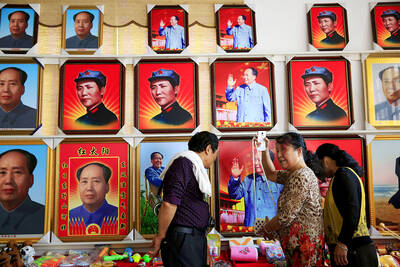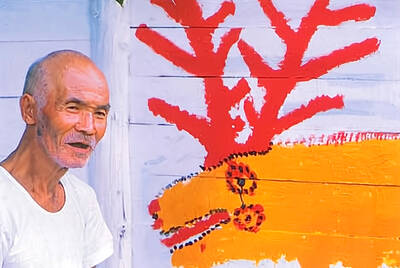As proven by his serial-killer mystery Memories of Murder (2003) and box-office record-breaking monster flick The Host (2006), South Korea’s Bong Joon-ho is a director who is adept at knitting a high level of entertainment with socio-political commentary.
For his latest work, Mother, Bong returns to the crime-thriller genre to tell a cleverly crafted story about a widow’s attempt to clear the name of her mentally and emotionally handicapped son, who has been accused of murder.
Revolving around the commanding central performance by veteran television thespian Kim Hye-ja, the film tones down the director’s fondness for broad messages and zooms in on maternal love pushed to extremes. It is both a well-executed noir thriller and a disturbing portrait of motherhood.
The film opens with Hye-ja (Kim Hye-ja), a long-widowed mother, chopping herbs inside a dingy herbal shop she runs to make ends meet in a small town. All the while, she stays alert to what happens on the street where her mentally handicapped son Do-joon (played by the almost unrecognizable heartthrob Won Bin) plays with a dog.
Suddenly, a Mercedes Benz knocks her son over and speeds off. Unhurt, Do-joon and his foul-tempered friend Jin-tae (Jin Goo) pursue the automobile to a golf course, where the dim-witted Do-joon collects several golf balls before he and his friend get into a dustup with the well-to-do hit-and-runners.
The next day, one of Do-Joon’s golf balls is found next to a murdered high school girl. An easy target for the lazy police to extract a confession, the young man is quickly convicted and jailed.
Finding no help from either the cops or the lawyer, Hye-ja, convinced that her son is innocent, takes matters into her own hands and embarks on a crusade to find the real killer.
Once the investigation begins, Mother kicks into high gear, honing a polished murder mystery filled with unexpected turns and twists. Tensions escalate as the film spirals in flashbacks and revelations that divulge dark secrets harbored inside the rural community and yet refuse to entirely mold the audience’s knowledge of the killer’s identity. The mood-drenched cinema-tography helps to create an aura of disquiet and foreboding with a stark palette of gloomy blues and greens.
The true genius of Bong is shown in the director’s wedding genre conventions with his own idiosyncratic vision that, in the case of Mother, blends maternal devotion with a diabolical murder to create a disturbingly loving and vicious human portrait.
More surprisingly, Bong is able to tell the audience everything they need to know about his compelling heroine even before the real narrative sets in. In the pre-credit sequence, Hye-ja dances on a meadow to the imaginary music in her head. She is graceful and alone, her wide, vacant eyes exuding poignant emotions that haunt the audience long after the end credits roll.
Without a doubt, the film’s most mesmerizing aspect is watching Hye-ja, the indomitable matriarch gradually turn into an inhuman force. The familiar small-town setting is reminiscent of Bong’s Memories of Murder in its ability to capture the mindset of a rural community. In Mother, the village is populated by scoundrels, whores and idiots for whom Hollywood-style justice and moral naivete are truly a fairy tale.
In the last, flickering shot, a murderer joins a group on a party bus. The passengers sing and dance like fools, while the murderer seems at once the most lucid and the craziest of them all.

Taiwan can often feel woefully behind on global trends, from fashion to food, and influences can sometimes feel like the last on the metaphorical bandwagon. In the West, suddenly every burger is being smashed and honey has become “hot” and we’re all drinking orange wine. But it took a good while for a smash burger in Taipei to come across my radar. For the uninitiated, a smash burger is, well, a normal burger patty but smashed flat. Originally, I didn’t understand. Surely the best part of a burger is the thick patty with all the juiciness of the beef, the

The ultimate goal of the Chinese Communist Party (CCP) is the total and overwhelming domination of everything within the sphere of what it considers China and deems as theirs. All decision-making by the CCP must be understood through that lens. Any decision made is to entrench — or ideally expand that power. They are fiercely hostile to anything that weakens or compromises their control of “China.” By design, they will stop at nothing to ensure that there is no distinction between the CCP and the Chinese nation, people, culture, civilization, religion, economy, property, military or government — they are all subsidiary

Nov.10 to Nov.16 As he moved a large stone that had fallen from a truck near his field, 65-year-old Lin Yuan (林淵) felt a sudden urge. He fetched his tools and began to carve. The recently retired farmer had been feeling restless after a lifetime of hard labor in Yuchi Township (魚池), Nantou County. His first piece, Stone Fairy Maiden (石仙姑), completed in 1977, was reportedly a representation of his late wife. This version of how Lin began his late-life art career is recorded in Nantou County historian Teng Hsiang-yang’s (鄧相揚) 2009 biography of him. His expressive work eventually caught the attention

This year’s Miss Universe in Thailand has been marred by ugly drama, with allegations of an insult to a beauty queen’s intellect, a walkout by pageant contestants and a tearful tantrum by the host. More than 120 women from across the world have gathered in Thailand, vying to be crowned Miss Universe in a contest considered one of the “big four” of global beauty pageants. But the runup has been dominated by the off-stage antics of the coiffed contestants and their Thai hosts, escalating into a feminist firestorm drawing the attention of Mexico’s president. On Tuesday, Mexican delegate Fatima Bosch staged a